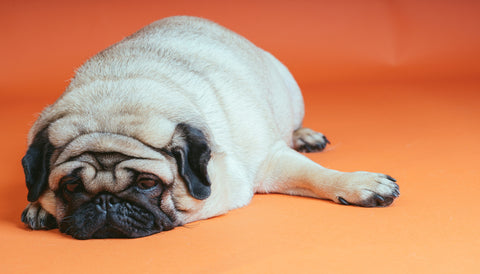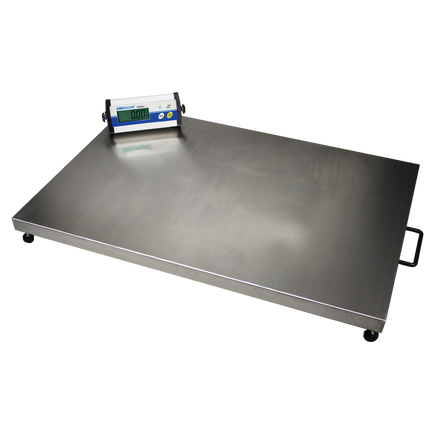
How to Weigh Your Dog at Home
Weighing your dog can say a lot about their overall health and can be crucial for their development. Understand why and how to weigh your dog at home in this blog, along with recommendations on which weighing scale is best for you.
Why is it important to weigh pets?
Pet obesity is a growing problem within the UK especially with the rise of families deciding to buy a ‘lockdown’ puppy during the Coronavirus pandemic. Vets estimate that nearly 50% of dogs in the UK are overweight. However, obesity isn’t the only reason why you should weigh your dog.
Weighing your dog or puppy can help eliminate any fears regarding their wellbeing. Along with a sudden drop or increase appetite or lethargy, a quick change in weight can be a clear sign there is a problem with your beloved dog and could indicate something serious.
Some problems associated with weight gain or loss are:
• Parasites
• Diabetes
• Poor nutrition
• Not enough exercise
• Chronic illnesses
You can read more about why accurate animal weighing is important here.
How often should I weigh my dog?

Before we look at how to weigh your dog at home, let's take a look at how often you should do so. Weighing your dog is dependent on two main factors: age and health. Although a vet will usually weigh your dog during any check-ups, it is perfectly acceptable for you to weigh your dog yourself more regularly, providing the process does not cause your pet any discomfort or stress.
In the early stages of a puppy’s life, it is extremely important to keep track of their weight to make sure they are developing at the correct rate. For the first six months they should be weighed regularly, every four weeks to avoid medical conditions such as hookworms or roundworms developing. We recommend the Adam MTB Portable Animal Scale as it comfortable, easy to clean and accurate for small naughty puppies.
If your dog has a medical condition that causes weight loss, such as Cushing’s Disease, you should be monitoring their weight more regularly. How regularly is dependent on the condition, and we’d recommend talking with your vet to decide how often your pet should be weighed.
How much should my dog weigh?
The average weight of a dog can be difficult, simply because all dogs are unique and have different conditions and requirements just like us humans, even if they are the same breed. If your dog is below or above their average weight it does not necessarily mean that they are unhealthy or have a medical condition.
This table provides some guidance on how much your dog should weigh.

How can I tell if my dog is overweight?
Firstly, check your dog’s body shape. Looking at your dog from above: if you notice that they look rather rotund and oval-shaped, it’s likely that your dog is overweight. However, on the other hand, if you notice that your dog has a defined waist toward the rear and a straight build down the sides, then they’re probably at a healthy weight.
Feel your dog’s ribs. The prominence of your dog’s ribs are a major indicator of weight issues. Dr. Sean McCormack, Head Vet for Tails.com states that “You should be able to feel the ribs with a slight covering of muscle over them, but they shouldn’t be visible, feel like sharp ridges or be poking out.”
Examine their behaviour. Overweight and obese dogs are typically inactive. If you notice that your dog has become lazy, has trouble walking, exhibits trouble breathing when walking, and generally appears to have trouble moving about, they are most likely overweight.

How can I weigh my dog at home?
To weigh your dog at home, you will first need to purchase an animal scale, also known as a vet scale. The scale will ideally have a Dynamic ‘Animal’ Weighing function that will give accurate results even if your wriggly furry friend is moving around.
When you have an animal scale, simply place your dog on the scale to get precise results. If your dog is hesitant, you may need to lure them in with a treat as we all know they cannot resist a tasty snack. If you have a senior dog and you want to make them at ease you can place their bed on the scale and use the Tare function to set it back to zero so that they can be weighed comfortably.
Once you have their weight on your scale, make sure you remember to record the result, along with the date that you weighed them to keep track of any changes.
Below are a few other tips you can follow:
• Remove their collar if they wear one
• Take them out for a toilet before you weigh them
• Avoid weighing just after they have eaten or had a drink, their tummy ideally needs to be empty
• Weigh them at the same time of day each time so the results are consistent
• Make sure their fur is completely dry, so water and dirt doesn’t affect the weight reading
Here are a few ways of how to weigh your dog at home in this video from PDSA.
What if my dog doesn't like being weighed?
The slight instability of a scale can be scary for dogs, particularly if they are already nervous in a medical setting. Therefore, weighing your dog at home can make them feel more comfortable and less stressed. If possible, begin weighing your dog regularly when they are a puppy, so they get used to the process.
Try Rewards. Rewarding your dog with a treat or a toy once onto the scale will help them become more confident and encourage them to get on the scale without any trouble.
Scales for weighing our furry friends
MTB Animal Weighing Scale

The MTB from Adam Equipment is a versatile weighing scale that is perfect for weighing small dogs. It is made from a smooth, comfortable material and features a rubber mat to ensure that the weighing pan remains secure at all times. It also incorporates a hold feature to capture your animal’s weight.
CPWplus L Dog Weighing Scale

The Adam Equipment CPWplus is perfect for weighing large dogs up to 300kg, such as Labradors, Golden Retrievers and Huskies. The large stainless steel weighing pan can be easily wiped down after use and the digital display is easy-to-read and housed in in a robust stainless-steel housing. Weighing is made easy with a hold function that is able to capture your dog’s weight accurately even if they are moving, in addition to this feature the option of a non-slip rubber mat, helps give your dog more stability.
Kern PCD Compact Precision Balance

For smaller new-born puppies, the Kern PCD compact balance features a separate base and removable display. This allows the display to be placed away from the puppy on the platform, helping to eliminate the chance of it getting bumped or damaged during weighing. With its vibration-free weighing feature, disturbances and movements are filtered out, resulting in a stable weight. The large back-lit LCD display is simple to read from a distance.
Now you know how to weigh your dog at home, need help with choosing a vet scale? No problem. Call the Inscale Scales team on 01908 972 660 and we’ll be happy to help!

Leave a comment